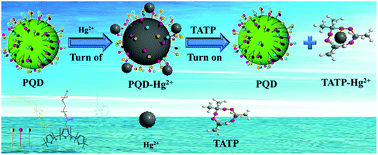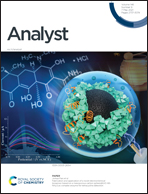Selective dual detection of Hg2+ and TATP based on amphiphilic conjugated polythiophene-quantum dot hybrid materials†
Abstract
The design of multifunctional sensors based on biocompatible hybrid materials consisting of conjugated polythiophene-quantum dots for multiple environmental pollutants is a promising strategy for the development of new monitoring technologies. Herein, we present a new approach for the “on–off–on” sensing of Hg2+ and triacetone triperoxide (TATP) based on amphiphilic polythiophene-coated CdTe QDs (PQDs, PLQY ∼78%). The emission of the PQDs is quenched by Hg2+ ions via electron transfer interactions. Based on the strong interaction between TATP and Hg2+ ions, the addition of TATP to the PQD-Hg2+ complex results in a remarkable recovery of the PQD emission. Under the optimized conditions, the PQD sensor shows a good linear response to Hg2+ and TATP with detection limits of 7.4 nM and 0.055 mg L−1, respectively. Furthermore, the “on–off–on” sensor demonstrates good biocompatibility, high stability, and excellent selectivity in the presence of other metal ions and common explosives. Importantly, the proposed method can be used to determine the level of Hg2+ and TATP in environmental water samples.



 Please wait while we load your content...
Please wait while we load your content...